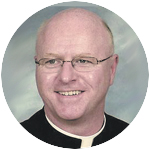
Msgr. Joseph Prior
(Readings of the Holy Mass – Fourth Sunday of Lent)
William Holman Hunt painted a work called “Light of the World,” which is on display at Saint Paul’s Cathedral, London. In the painting, he depicts Jesus wearing a crown of thorns standing before a closed door in a small house in a wooded field. His face is illumined by the lantern he carries at his side in his left hand. His right hand is raised and knocking at the door to the house. This house has no handle on the outside of the door. There is a story told that someone said to the artist, “how is Jesus supposed to get in?” The artist replied, “The handle is on the inside, the only way for the Light to get in is to open the door from within.”
Jesus refers to himself as the “Light of the World,” in today’s gospel passage from the Gospel According to John. Looking to the natural world we can greatly appreciate the gift of light and its use as an image. Light is associated with life, for light is needed for life. In the natural order of things, the daytime is when we have most of our activity, interactions, engagements and so forth. We do things when we have light. Most of the time of darkness, night, is spent asleep. This time of the year when the days are getting longer and we have more light many people seem more upbeat, happy, and full of life. So the image Jesus takes to Himself is a rich and vibrant one, a “brilliant” image associated with life.
The Johannine passage recalls the story of the man born blind whom Jesus heals. In this passage, the images of light and darkness, faith and doubt, mercy and forgiveness are all interwoven. The man born blind has been living in darkness his entire life. For those of us who see, this is hard to imagine, never having sight. The person sees not the sky, nor the earth, nor color, nor parents, nor family, nor friends, nor the forests, nor flowers. They have no concept of these images. It is a world of darkness. Jesus, the Light, comes into that world and dispels the darkness. He gives the man sight. He gives the man life.
The encounter had begun when Jesus’ disciples saw the man along the way and asked Jesus a question. “Who sinned, this man or his parents?” At that time, in Jewish thought, physical disabilities or deformities were associated with sin – as a consequence of sin. Jesus says this is not the case. As to why the man was born blind, Jesus says it is so that God’s glory may be manifest. This happens when Jesus heals the man. As the story progresses, we will see another type of blindness, not related to physical sight. This is the blindness of the Pharisees and this blindness Jesus associates with sin.
After the man is healed the townsfolk recognize him and the miracle that has taken place. When asked, the man identifies Jesus as the source of his healing. The townsfolk are amazed and take the man born blind to the Pharisees. The Pharisees hear the story. The people who bring the man know that he was blind and now sees. The Pharisees refuse to believe. They question the man who explains his blindness from birth and the healing. The Pharisees refuse to believe. They question the man’s parents, who also confirm his previous condition. They refuse to believe.
When they had questioned the man born blind a second time, he replies: “This is what is so amazing, that you do not know where he is from, yet he opened my eyes. We know that God does not listen to sinners, but if one is devout and does his will, he listens to him. It is unheard of that anyone ever opened the eyes of a person born blind. If this man were not from God, he would not be able to do anything.”
Now the Pharisees say, “You were born totally in sin, and are you trying to teach us?” After this they throw him out. The obstinacy of the Pharisees is the blindness related to sin. As Jesus says to them at the end of the passage, “If you were blind, you would have no sin; but “We see,” you say, so your sin remains.”
Jesus is the Light that dispels darkness. With His life comes life which we will see even more explicitly in next weeks gospel when Lazarus is brought forth from the darkness of death and the tomb and restored to light and life. By the end of the story the man born blind has come to faith in Jesus. When Jesus asks him “Do you believe in the Son of Man?” he replies “Who is he, sir, that I may believe in him?” Then Jesus says, “You have seen him, and the one speaking with you is he.” At this point the man born blind says, ““I do believe, Lord,” and he worshiped him.”
In the Holman Hunt painting, “Light of the World,” the person is represented by the house. Jesus is regularly “knocking at the door.” He wants to enter and to bring with him Light. We have many rooms in our homes. Jesus wants to come into all of them. As we continue our Lenten journey, we will hear him knock. When we do so, open the door. His light will dispel the darkness, will heal what needs healing, and restore life.
***
Msgr. Joseph Prior is pastor of Our Lady of Grace Parish, Penndel, and a former professor of Sacred Scripture and rector of St. Charles Borromeo Seminary.
PREVIOUS: 4 Ways to Practice Prayer During the Season of Lent
NEXT: 4 Ways to Practice Fasting and Abstinence During the Season of Lent



Share this story